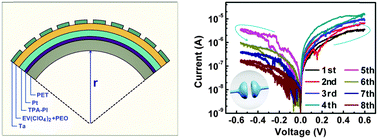Synaptic plasticity and learning behaviours in flexible artificial synapse based on polymer/viologen system†
Abstract
In this study, an artificial synapse with a sandwich structure of Ta/ethyl viologen diperchlorate [EV(ClO4)2]/triphenylamine-based polyimide (TPA-PI)/Pt is fabricated directly on a flexible PET substrate and exhibits distinctive history-dependent memristive behaviour, which meets the basic requirements for synapse emulation. Essential synaptic plasticity (including long-term plasticity and short-term plasticity) and some memory and learning behaviours of human beings (including the conversion from short-term memory to long-term memory and the “learning–forgetting–relearning”) have been demonstrated in our device. More importantly, the device still exhibits the synaptic performance when the surface strain of the device reaches 0.64% (or, the bending radius reaches 10 mm). Moreover, the device was able to endure 100 bending cycles. Our findings strongly demonstrate that the organic artificial synapse is not only promising for constructing a neuromorphic information storage and processing system, but is also interesting for the realization of wearable neuromorphic computing systems.


 Please wait while we load your content...
Please wait while we load your content...